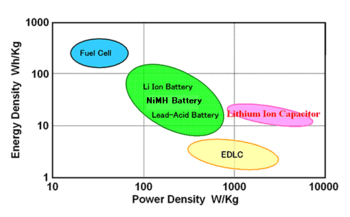Lithium-ion capacitor

| Specific energy | 11–14 W·h/kg |
|---|---|
| Energy density | 19–25 W·h/L |
| Specific power | 160–2800 W/kg |
| Charge/discharge efficiency | 95% |
| Self-discharge rate | < 5% per month (temperature dependent) |
| Cycle durability | >10,000 |
| Nominal cell voltage | 2.2–3.8 V |
A lithium-ion capacitor (LIC) is a hybrid type of capacitor out of the family of the supercapacitors. Activated carbon is used as cathode. The anode of the LIC consists of carbon material which is pre-doped with lithium ion. This pre-doping process lowers the potential of the anode and allows a relatively high output voltage compared with other supercapacitors.
History
In 1981, Dr. Yamabe of Kyoto University discovered PAS (polyacenic semiconductive) material in collaboration with Dr.Yata of Kanebo Co. It is prepared by the pyrolysis of phenolic resin at 400–700 °C.[1] This amorphous carbonaseous material has excellent features as the electrode for high-energy-density rechargeable devices. The related patents were filed in the early 1980s by Kanebo Co.,[2] and started to develop towards the commercialization of PAS battery and lithium ion capacitor(LIC). The PAS battery was put in use in 1986,[3] and LIC in 1991.
Concept

A lithium-ion capacitor is a hybrid electrochemical energy storage device which combines the intercalation mechanism of a lithium ion battery with the cathode of an electric double-layer capacitor (EDLC). The packaged energy density of an LIC is approximately 20 W·h/kg generally four times higher than an EDLC and five times lower than a lithium ion battery. The power density however has been shown to match that of EDLCs able to completely discharge in seconds.[4] The negative electrode (cathode) often employs activated carbon material at which charges are stored in an electric double layer that is developed at the interface between the carbon and the electrolyte.
The positive electrode (anode) was originally made with lithium titanate oxide, but is now more commonly made with graphitic carbon material to maximize energy density. The graphitic electrode potential initially at -0.1 V versus SHE (standard hydrogen electrode) is lowered further to -2.8 V by the intercalation of lithium ions. This process step is referred to as doping and often takes place in the device between the anode and a sacrificial lithium electrode. The pre-doping process is critical to the device functioning as it can significantly affect the development of the Solid Electrolyte Interphase layer. Doping the anode lowers the anode potential and leads to a higher output voltage of the capacitor. Typically, output voltages for LICs are in the range of 3.8–4.0 V but are limited to a lower voltage of 1.8–2.2 V. If the voltage is brought any lower lithium ions will deintercalate more rapidly than they can be restored during normal use. Like EDLCs, LIC voltages vary linearly adding to complications integrating them into systems which have power electronics that expect the more stable voltage of batteries. As a consequence, LICs have a high energy density, which varies with the square of the voltage. The capacitance of the anode is several orders of magnitude larger than that of the cathode. As a result, the change of the anode potential during charge and discharge is much smaller than the change in the cathode potential.
The electrolyte used in an LIC is a lithium-ion salt solution that can be combined with other organic components and is generally identical to that used in lithium ion batteries.
A separator prevents direct electrical contact between anode and cathode.
Properties
Typical properties of an LIC are:
- high cell capacity, because of the large anode capacity
- high energy density (14 Wh/kg reported[5])
- high power density
- high reliability
- operating temperatures ranging from −20 °C to 70 °C
- low self-discharge (<5% voltage drop at 25 °C over three monthsreported in [Ref 1])
Comparison to other technologies

Batteries, EDLC and LICs all have their own properties, which make them suitable for specific applications. The lithium-ion capacitors have a higher power density as compared to batteries, and LIC’s are safer in use than LIBs, in which thermal runaway reactions may occur. Compared to the electric double-layer capacitor (EDLC), the LIC has a higher output voltage. They have similar power densities, but energy density of an LIC is much higher.
The Ragone plot (figure 1), shows that the lithium-ion capacitor combines the high energy of LIBs with the high power density of EDLC’s.
Cycle life performance of LICs is much better than batteries and is similar to EDLCs.
Applications
Lithium-ion capacitors are quite suitable for applications which require a high energy density, high power densities and excellent durability. Since they combine high energy density with high power density, there is no need for additional electrical storage devices in various kinds of applications, resulting in reduced cost of ownership.
Potential applications for lithium-ion capacitors are, for example, in the fields of wind power generation systems, uninterruptible power source systems (UPS), voltage sag compensation, photovoltaic power generation, energy recovery systems in industrial machinery, and transportation systems.
References
- ↑ Prc.Annual Meeting of the Physical Society of Japan(Yokohama) 31p-K-1, 1982, March
- ↑ Japanese patent application No. 56-92626,1981
- ↑ International Conference on Science and Technology of Synthetic Metals 1986,Kyoto
- ↑ "Evaluation of lithium-ion capacitors assembled with pre-lithiated graphite anode and activated carbon cathode". Electrochimica Acta. 65: 280–287. 20 March 2012. doi:10.1016/j.electacta.2012.01.076. Retrieved 2014-01-14.
- ↑ "FDK To Begin Mass Production of High-Capacity Li-Ion Capacitors". 4 January 2009. Retrieved 23 July 2010.
External links
- Introducing JM Energy Lithium Ion Capacitor, JM Energy
- Lithium Ion Capacitor, JSR Micro